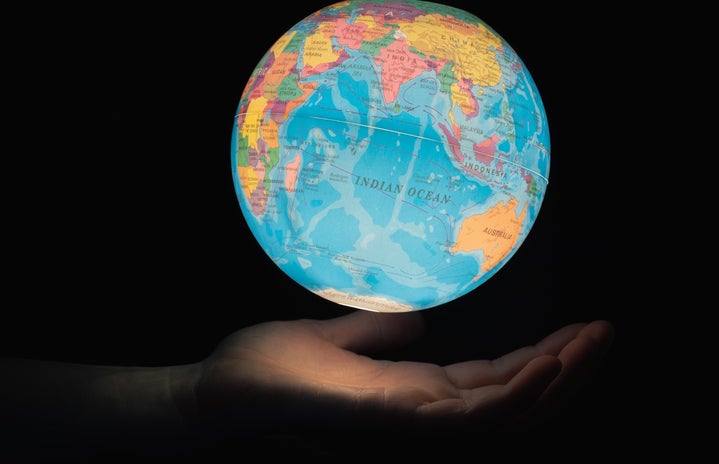We live in a world of rampant misinformation and instant gratification. Quick Google searches permeate our consciousness with quick easy answers without actively taking a step to truly understand something beyond the surface level. Our media is no stranger to this either whether it be through a constant showing of violent images of the Middle East, claiming coronavirus only affected a specific demographic, or claiming to be “shocked” when a racist former President wouldn’t condemn White supremacy. They give in to convenient narratives as a way to get a viewer’s attention and heightened response.
It was reported recently—or rather misreported—that U.S. troops were withdrawn completely from Afghanistan. For one, the fact is around 2,500 troops still remain and the real story at hand is the war-torn condition that U.S. imperialism has caused Afghanistan to be in the first place. A quick Google search dictates that U.S. involvement in Afghanistan began in 2001, post 9/11 during the Bush administration. Considering all the conspiracy heightened around the true nature of 9/11, I immediately recognized this to be false. Only when you search U.S.-Afghanistan Cold-War do you get a full picture of an accurate timeline. Our involvement in Afghanistan started in the 70s, during the Cold War because of Soviet involvement, but the preferred narrative is a post 9/11 one in order to combat counterterrorism.
Here is an accurate timeline of the events surrounding Afghanistan:
Afghanistan and the Soviet Union’s Friendship: The Cold War History
Source: https://web.stanford.edu/class/e297a/Afghanistan,%20the%20United%20States.htm
1934 – The U.S. officially recognizes Afghanistan’s independence, and sets up an embassy in Kabul, the country’s capital.
1946 – The U.S. Morrison Knudsen Company loans the country $20 million for construction and irrigation systems. It’s important to note the king at the time was committed to taking Afghanistan out of its underdeveloped state.
1973 – Russia (formerly the Soviet Union) has lent upwards of a billion dollars to the country as well. They had strong ties.
1979 – The Cold War heightened and tensions began arising. The U.S. was increasingly suspicious of the Communist upper hand that the Soviet Union was trying to impose. They were suspicious of “expansionist tendencies.”
Christmas Eve 1979 – Soviet Union troops invade Afghanistan by the thousands.
1986 – The Soviet Union is aware of the toll and costs this war is taking and consider withdrawal.
1988 – Mikhail Gorbachev announces Soviet withdrawal, and the U.S. agrees to stop interference in Afghanistan. The U.S. withdrawal created a power vacuum as well as an economic one. Afghanistan begins a descent into disarray.
Also in 1988 – It’s confirmed in interviews that the CIA was providing covert aid to train Afghani fighters against a Soviet invasion. Afghanistan became a pawn in the U.S.-Soviet Union Cold war.
These fighters were known as mujahideen, resistance fighters, or fighters of faith. One of the people trained by the CIA was Osama Bin Laden. After the U.S. departure, 3 million Afghani refugees fled to Pakistan, the mujahideen among them.
1994 – The Taliban emerges as a group. It was a group of Pashtun Islamic Fundamentalist students from Pakistan, who received their training from the CIA-Backed former mujahideen. These men were refugees who passed on their training after the U.S. departed.
1996 – Because Afghanistan did not have a stable government, the Taliban was able to capture the capital, Kabul, and become the governing entity. It’s important to note the Taliban was extremely oppressive and the U.S.-supported them initially.
Post 9/11 Popular Narrative
Source: https://www.cfr.org/timeline/us-war-afghanistan
September 11, 2001 – The 9/11 attacks occur.
September 18, 2001 – Bush swears to combat terrorism and signs a joint resolution authorizing for force to take down those responsible for the attacks. Meaning, the U.S. was in Afghanistan for the first time since the Cold War.
December 9, 2001 – While the Taliban Regime collapses at this time, Al-Qaeda leaders continue to hide out in the mountains.
2001-2011 – Different administrations have agendas of reconstructing Afghanistan and capturing Al- Qaeda affiliates. Afghanistan has various leadership transitions but there continues to be a constant state of disarray. No real change or government is able to persist.
May 1, 2011 – Osama Bin Laden is killed in Pakistan.
October 7, 2011 – Ten-year anniversary of the U.S. presence in Afghanistan (since 2001 that is).
A more extensive timeline till 2014: https://www.pbs.org/newshour/politics/asia-jan-june11-timeline-afghanistan
November 17, 2020 – The U.S. announces its withdrawal from Afghanistan, reducing the count to 2,500 troops.
The timeline is meant to show what happens when you deep-dive on a subject beyond a surface level. It’s not meant to paint a black-and-white picture of who’s right or wrong, but rather to actively question the U.S.’ position in what they do in other countries for the sake of democracy. American media is obsessed with the glorification of these conflicts whether through violence or recycled narratives of tension. When you continuously see a place being branded as “unstable” and see horrifying images on your screen, the cycle creates apathy. It makes it difficult to empathize with people from that place. The media fails to question and understand the impact it has on people of that region because it is too busy trying to get your attention.
A news segment from the BBC covered a different aspect of this conflict, and that is the lives of the citizens in Afghanistan. Sadly, Afghanistan is facing a humanitarian crisis, and poverty rates continue to increase. The images of children unable to eat because there is no food around are haunting. Women and children continue to be displaced and face violent situations. At the end of the day, it’s the people who live in these countries that suffer the most from war, instead of those paying money to fight it.
The IRC (International Rescue Committee) is committed to helping refugees worldwide, including Afghanistan, and has held a presence since 1988. Read more here: https://www.rescue.org/country/afghanistan


